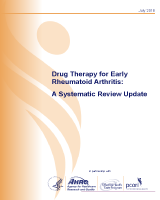NCBI Bookshelf. A service of the National Library of Medicine, National Institutes of Health.
Donahue KE, Jonas DE, Hansen RA, et al. Drug Therapy for Rheumatoid Arthritis in Adults: An Update [Internet]. Rockville (MD): Agency for Healthcare Research and Quality (US); 2012 Apr. (Comparative Effectiveness Reviews, No. 55.)
This publication is provided for historical reference only and the information may be out of date.
Strength of evidence for Disease Activity and Radiographic Progression (KQ1)
For each comparison, the following tables provide the strength of evidence for disease activity and radiographic outcomes within a single row, if both outcomes were available. Information related to disease activity is provided in the upper part of each row; information related to radiographic outcomes is provided in the lower part of each row, when available.
Table 1. Strength of evidence for Disease Activity and Radiographic Progression (KQ1) (MS Word, 85K)
Strength of evidence for functional capacity and quality of life outcomes (KQ2)
For each comparison, the following tables provide the strength of evidence for functional capacity and quality of life outcomes within a single row, if both outcomes were available. Information related to functional capacity is provided in the upper part of each row; information related to quality of life is provided in the lower part of each row, when available. If only one study provided all of the evidence for a comparison and had consistent results for functional capacity and quality of life outcomes (i.e. finding no difference or one treatment better than the other), we inserted a single set of entries in the row, rather than repeat the same information twice.
Table 2. Strength of evidence for functional capacity and quality of life outcomes (KQ1 and KQ2) (MS Word, 81K)
Strength of evidence for Harms, Tolerability, Adverse Effects or Adherence for Corticosteroids (KQ3)
For each comparison, the following tables (Table 3 and 4) provide the strength of evidence for harms, tolerability, adverse effects, and adherence. The table is organized by drug comparisons among corticosteroids, oral DMARDs, and biologic DMARDs. Comparisons are further grouped by subheadings for overall tolerability specific adverse event categories, and adherence. Categories with no evidence are excluded from the table.
Table 3. Strength of evidence for corticosteroids (KQ3) (MS Word, 67K)
Table 4. Strength of evidence for oral DMARDs (KQ3) (MS Word, 71K)
Table 5. Strength of evidence for biologic DMARDs (KQ3) (MS Word, 74K)
Table 6. Strength of evidence for adherence (KQ3) (MS Word, 67K)
For each comparison, the following table provides the strength of evidence for benefits and harms. The table is organized by subgroup, then by drug comparisons.
Table 7. Strength of evidence for Benefits and Harms for Selected Populations (KQ4) (MS Word, 69K)
- Strength of Evidence Tables - Drug Therapy for Rheumatoid Arthritis in Adults: A...Strength of Evidence Tables - Drug Therapy for Rheumatoid Arthritis in Adults: An Update
Your browsing activity is empty.
Activity recording is turned off.
See more...

